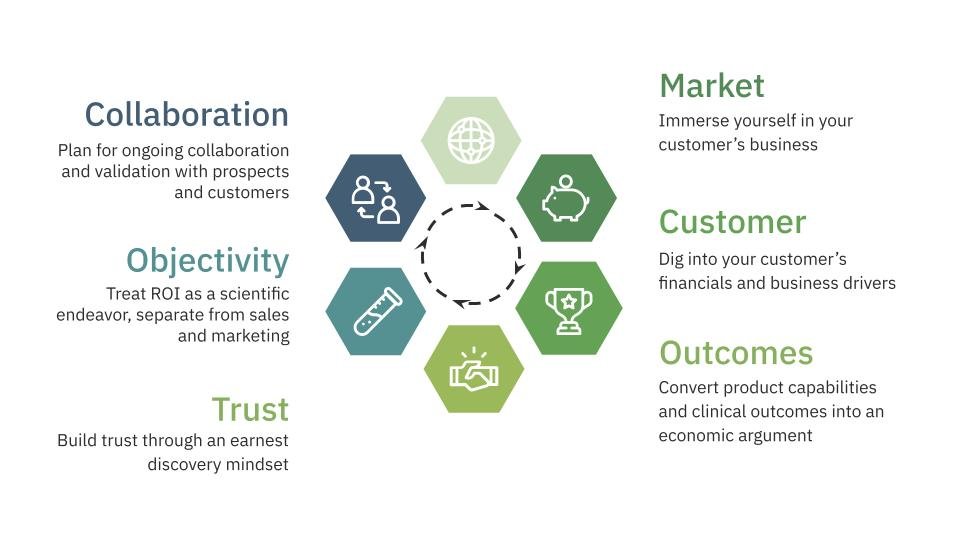Empathy-powered ROI: A Digital Health ROI Framework
A company's ability to communicate its value through ROI is more vital today than ever before.
Chronically low operating margins are placing tremendous financial strain on many health systems, who must see the economic return of an investment. The continued expansion of value-based care demands a precise consideration of cost to make the value equation sustainable. And with an increasingly crowded digital health ecosystem, ROI is a critical differentiator.
On top of all this, a recent GSR Ventures survey revealed that digital health investors believe ROI is the #1 factor for a company's success in healthcare.
A Misguided Approach to Digital Health ROI
Many digital health companies are so focused on building their technology that they underinvest in building a robust return on investment (ROI) model - or misunderstand the point of these models entirely.
Too often, in the midst of a thousand other priorities, digital health CEOs or commercial leaders looking for immediate market progress ask for an ‘ROI calculator’. But to view ROI as a calculator is to think of a computer as a typewriter. While one can use a computer to compose sentences, its utility and value is - and should be - far greater.
The output of an ROI exercise should therefore not be a calculator, but a model—an attempt to understand the rules and logic that dictate the way the client’s world works, and if and how that world can be measurably improved by the digital health solution. An ROI model is an investment in understanding a customer’s reality. It is an act of empathy, requiring a paradigm shift from a product-centric view towards a market-centric view, to understand what drives, or diminishes, the growth and success of a customer’s business.
ROI is the economic expression of a company’s value proposition. It is not mere numbers in a spreadsheet; it is an objective, measurable and authentic means of communicating one’s economic value—cutting through the hype, hyperbole and sentimentalism of typical sales and marketing.
A Framework for Empathetic ROI
Embracing ROI in its fullest form means viewing it as an underlying market philosophy, business strategy and communication framework. Healthcare companies that wish to embrace a more strategic, comprehensive approach to ROI should consider the following framework to drive strategic growth and resonance in the market:
Summit Health Advisors’ Digital Health ROI Framework.
1. MARKET: Immerse yourself in your customer’s business
Take time to understand the healthcare policies and funding models that shape the market. Which reimbursement models are at play: fee-for-service, bundled, capitated? What clinical and demographic populations do your customers serve? Is there pending legislation or care models that could impact staffing requirements, quality metrics or reimbursement once implemented?
Further, tracking secular market forces—from investment flow to competitive entrants to M&A activity—is also useful to understand the potential opportunities and threats for your customers - and how your ROI model can be best positioned to address these factors.
2. CUSTOMER: Dig into your customer’s financials and business drivers
Where possible, analyze your ideal customers’ financial statements, SEC filings and earnings calls to understand their business. By reviewing enough of these documents, you can create a composite view not only of your ideal customer’s financial strengths and struggles, but also understand what they perceive to be their core economic drivers and key metrics. Knowing a customer’s revenue model, payer mix, cost structure and cost drivers is critical to telling the right story and framing your product correctly.
In addition, financial filings and earnings calls will shed light on industry head/tailwinds, primary economic drivers, key success metrics, and the language customers use to discuss their business - basically serving as a cheat sheet to developing your value props, and corresponding ROI.
3. OUTCOMES: Convert product capabilities into an economic argument
ROI should become a forcing function to think about your product in terms of value to the customer, rather than features and capabilities. It flips an inward product focus to an outward market/customer focus. While your product may improve diagnostic accuracy, what matters for ROI is the ultimate downstream economic impact.
Similarly, while clinical validations are critical to a digital health company’s success, true ROI must transpose these clinical outcomes into a key that will resonate with business stakeholders - who, more often than not, possess decision making or approval authority. By linking clinical and economic value through ROI, you can now communicate with multiple stakeholders at once - vastly increasing the power, efficiency and integrity of each value proposition.
Access the ROI Case Study
See how our ROI approach helped Swift Medical become the leader in a new healthcare market.
4. TRUST: Build trust through a discovery mindset
Presenting ROI as simply a slide in a sales deck misses a critical chance to meaningfully engage other parts of a prospective customer’s organization, as well as a chance to learn more about the customer.
For instance, a surface level finding might include learning about a customer’s previous efforts to address the same challenge, what their experience was and what the results were. A deeper finding may be understanding the internal politics at play within the organization, which departments value what things and therefore how to deliver a message that resonates with each one. And still yet a deeper finding may be financial insights the finance department or CFO typically has. This deeper knowledge is sourced from a part of the organization that a sales person typically does not have access to. All of this information can increase the confidence and knowledge for the next prospect.
5. OBJECTIVITY: Treat ROI as a scientific endeavor
It may not be realistic or fair to charge go-to-market teams (sales and marketing) with ROI. They are, and should be, responsible for increasing awareness, driving pipeline activity and closing deals - all geared toward persuading prospects to buy - and not managing an ROI exercise that is an intrinsically nuanced, fact-based process to study and reveal how customers realize value.
ROI and clinical validations should be presented and managed as a scientific or academic endeavor: an objective, data-driven discussion about value. Putting responsibility for these roles into distinct functions - often under a Chief Medical Officer or Chief Strategy Officer, within a Business Intelligence or Analytics group - can help to maintain proprietary and build long term trust with customers and in the market more broadly.
6. COLLABORATION: Plan for ongoing collaboration and validation
At the beginning, your ROI model will be hypothesis heavy, which is normal. Even with extensive market research, expect to revise and tighten your model with each customer conversation.
Having a model in place can also help guide where resources (for you and your customer) should be directed to validate clinical, operational and financial outcomes. Developing a plan to do this important work - starting with testimonials and case studies, and then progressing to robust data collection, analysis, and eventually peer reviewed publications - can give customers and investors alike confidence that the company is dedicated to building a scalable business that delivers real, proven and sustainable value.
A robust ROI model should not replace clinical or operational value propositions, nor should it necessarily change how digital health companies message to or engage with prospects. However, an effective ROI model and process should help the administrative and financial parts of a customer’s organization easily comprehend the value that will be delivered to their bottom line in exchange for their investment in the solution.
A well-crafted ROI model can help cut through the chaos, demonstrating a deep, empathetic understanding of a customer’s business and an objective, data-driven plan to help them grow it.
Need help developing an ROI approach for your digital health business? We’d love to help. Please reach out.
Read our Managing Director Seth Joseph’s full article on digital health ROI in Forbes.



